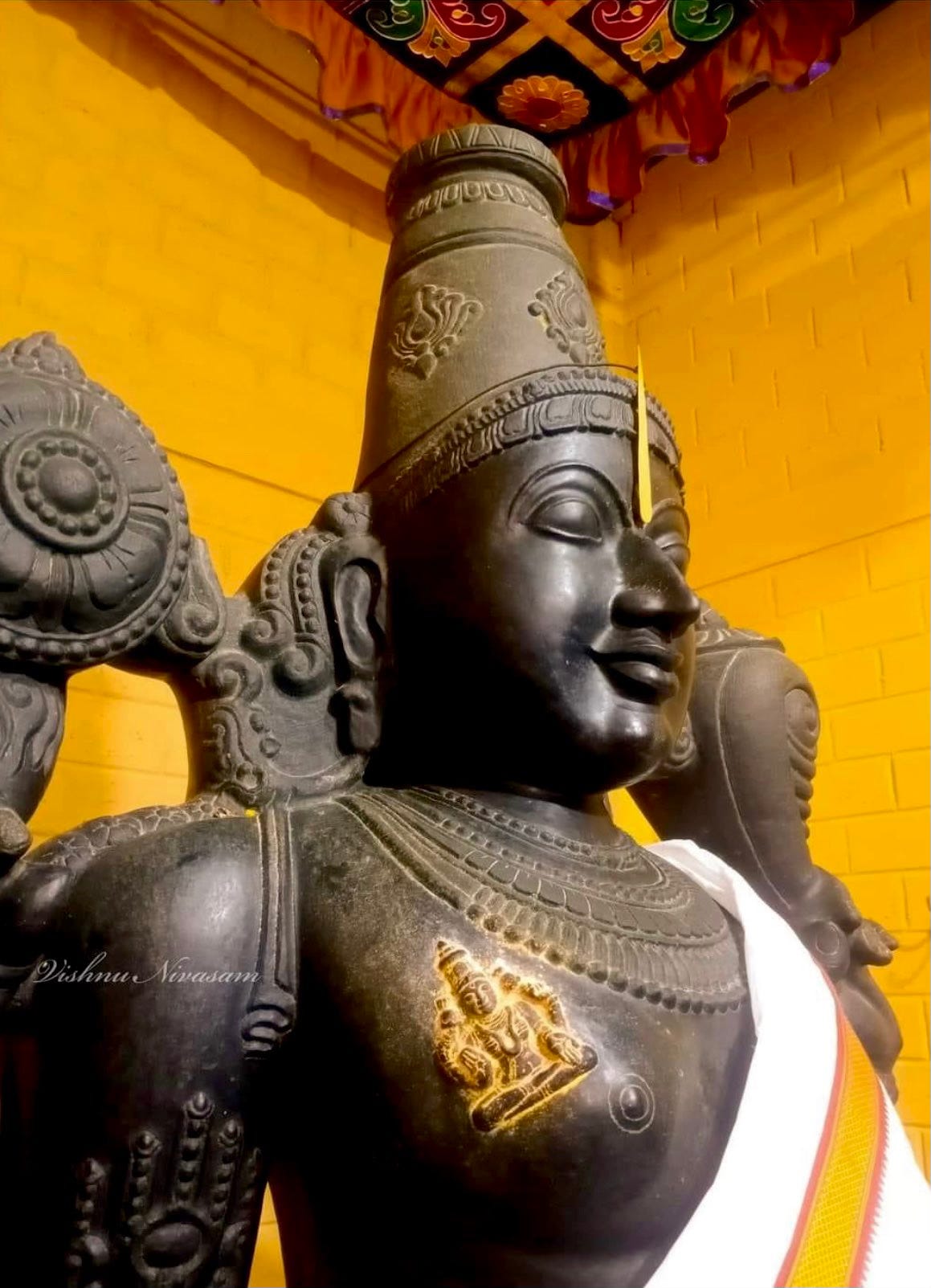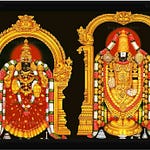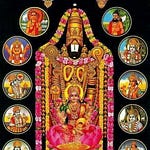Good morning! Today's verse marks a distinct shift in the Śrī Veṅkaṭeśa Suprabhatam, marked by a change in the refrain (the fourth line of every verse). The verse is also a long and fascinating string of invocations of the names of Lord Veṅkaṭeśvara.
Śrīmann! [1] Abhîṣṭa(!)(-)Varadâ! [2] ’khila(!)(-)loka-bandho! [3] Śrī(ḥ!)(-)Śrīnivāsa! [4] Jagad-eka(!)(-)dayaîka-sindho! [5] | Śrī-devatā-gṛha(!)(-)bhujântara(!)(-)divya-mūrte! [6] Śrī-Veṅkaṭâcala-pate! [7] tava suprabhātam || (VSu 13) श्रीमन्न्! अभीष्ट(!)(-)वरदा! ऽखिल(!)(-)लोक-बन्धो! श्री(:!)(-)श्रीनिवास! जगद्-एक(!)(-)दयैक-सिन्धो! श्री-देवता-गृह(!)(-)भुजान्तर(!)(-)दिव्य-मूर्ते! श्रीवेङ्कटाचल-पते! तव सुप्रभातम् ॥
[1] O Lord inseparable from Śrī! [2] Bestower of the best of Our desire! [3] Kinsman to the cosmos, All of it, without remainder! [4] Auspicious Abode of Śrī! [5] Ocean of solely Compassion solely for the world! [6] Divinely beautiful form through Your vast chest which is Home to the auspicious Śrīdevī! [7] O Lord of the sacred mountain wealth-weaving, sin-cleaving Venkatam, a blessed morning unto You!
As mentioned above, this verse is a string of sambodhanas (invocations) addressed to Lord Veṅkaṭeśvara, but one of the challenges here lies in determining precisely how many invocations there even are, and what they are! Thus does the beauty (and complexity) of Sanskrit come into play. To keep this post readable, I’ve moved all of the references to Pāṇinian grammar to the footnotes.
Let us now look through the invocations, one by one.
A unambiguous opening
The first name is unambiguous: Śrīman.1 It immediately relates Lord Veṅkaṭeśvara as the one who eternally has Śrī, and who is inseparable from Her. It is not an exaggeration to state that this word is the foundation of all Śrīvaiṣṇava theology, as it articulates the fundamental relationship between these two aspects of the Divine.
Without getting into those very deep waters, we can nevertheless notice that the first invocation to Padmāvatī Tāyār in the Suprabhātam, all the way back in verse 3, is Mātar (“Mother!”). Thus, we devotees are directly related to Her as our Mother. In this verse, we devotees relate to Lord Śrīnivāsa through Tāyār, with whom He is inseparably, eternally intertwined. (This is one of the key elements of Śrīvaiṣṇava soteriology, according to which the Goddess plays the role of a loving mother mediating between us (their naughty children) and their father, who is also loving but who also wants his children to be disciplined.)
After this name come the ambiguities of interpretation!
Granter of boons
When we approach the Lord through His ever-loving Spouse the Cosmic Mother, what does He do for us? He grants us what we want! This is expressed in the next cluster of names, abhîṣṭa-varada, which can be understood in three different ways:
Taken as a whole, abhîṣṭa-varada means “granter of our most desired boons”.
But we can also read this as two separate names:
abhîṣṭa on its own means “the most desired one”: Lord Veṅkaṭeśvara is what we [should] desire the most of all things.
varada on its own itself means “giver of the choicest boons”.
It is also a reference to Lord Varadarāja of Kāñcīpuram, another one of the most famous of all the shrines to Śrīman-Nārāyaṇa, and a particular favorite of Swāmī Vedânta Deśika. Incidentally, Śrī PB Aṇṇan Swāmī’s birth-name, chosen due to his birth-place, was Hastigiri-nāthan, which is another name for Lord Varadarāja of Kāñcīpuram.
Additionally, Varada is also one of the names for Lord Mahāviṣṇu in the Viṣṇu Sahasranāma.2
Thus, all taken together, this cluster supplies us with a few clear lessons:
Lord Veṅkaṭeśvara, approached through Padmāvatī Tāyār, will grant us everything we desire.
What we should desire above all else is Lord Veṅkaṭeśvara with Padmāvatī Tāyār: proximity to Them, service to Them, devotion to Them.
The Divine Couple will guide us to Them. (This is the notion of upāya and upeya that we saw at the very end of verse 12 as well.)
A hint of self-surrender
The first two names taken together, śrīmann abhîṣṭa-varada, is a clear reference to the famous fourth verse of the famous Nyāsa-daśaka (“Decad on Setting Down Our Burdens”) of Swāmī Vedânta Deśika, which also begins with the same words:
Śrīmann! Abhîṣṭa(!)(-)Varada! tvām asmi śaraṇaṃ gataḥ | etad-dehâvasāne māṃ tvat-pādaṃ prāpaya svayam || (NyāD 4)
O Lord inseparable from Śrī! Bestower of the best of Our desire! I have taken refuge in You alone. When this body is finally discarded, guide me Yourself to Your own lotus-feet.
Friend to the Universe
But why should the Lord grant us anything at all? He has no obligations to do so, after all. The next name, and its three interpretations, tells us why:
Taken as a whole, akhila-loka-bandhu means “Kinsman/friend to the entire cosmos”. This is parallel to the idea of Padmāvatī Tāyār as Mother of the whole universe and is a statement of great comfort to us: No matter who we are, where we are, we can always turn to Lord Veṅkaṭeśvara and Padmāvatī Tāyār and be assured of Their fullest love.
But we can also read this as two separate names:
akhila on its own means “complete, whole, without remainder”, which is a perfect description of Lord Śrīnivāsa.
loka-bandhu on its own also means “Kinsman/friend to the cosmos” and thus captures the same meaning as the fuller name.
Additionally, loka-bandhu is also one of the names for Lord Mahāviṣṇu in the Viṣṇu Sahasranāma.3
As we also saw in verse 12 with the double interpretation of Padmêśa-mitra, we can understand loka-bandhu in two different ways (in technical language, as tatpuruṣa or as bahuvrīhi), to mean both that the world is the Lord’s friend and that the Lord is the world’s friend.
The internal relation of the Divine Couple

Having seen the relation of the Divine to the non-divine, the next cluster of names turns to the internal relationship within the Divine Couple:
As a single unit, Śrī-Śrīnivāsa is straightforwardly “auspicious/blessed Śrīnivāsa”. As the ultimate abode of infinitely many positive qualities, He is the most deserving of this appellation.
But we can also read this as two separate names, on the basis of some slightly tricky but perfectly legitimate Sanskrit grammatical rules:4
The second of these two names would be Śrīnivāsa, the famous name for the Lord of Tirupati. The name, as is well known, means “Śrī’s Abode”, for She dwells eternally on His chest.
The first of these names is Śrī itself: yes, we are calling Him by Her proper name! This is a display of deep love and affection for the Divine Duo and a recognition of their inseparability—just as we saw in verse 12 as well. Indeed, Tirumaṅgai Āḻvār himself does this in a famous pāsuram (Pĕriya Tirumŏḻi VII.7.1a) that begins with the phrase Tiruvukkum Tiru vāgiya sĕlvā (திருவுக்கும் திருவாகிய செல்வா): “O my Treasure who has become Tiru even to Tiru Herself!”
Thus, with this one cluster of names, we see that:
He is She.
He is also Her abode.
He is auspicious because of these two above points.
No wonder She declares in Her own words, as She dwells on His chest, in Nammāḻvār’s beautiful words (Tiru-vāy-mŏḻi VI.10 (Ulagam uṇḍa).10a): agalagillēn iṟaiyum (அகலகில்லேன் இறையும்), “I am not going to separate from Him, not even for an instant.”
A singular ocean of compassion
The next cluster can also potentially be split to give us three names, but here I think it is better to keep it as a single name: jagad-eka-dayā-eka-sindhu, the universe’s unique, singular, ocean of made up solely of pure compassion. Note the repetition of the word eka “one”:
For the entire world, He is the sole refuge.
His constitution is pure compassion, unadulterated by anything else.
This statement echoes the famous verse 21 of Swāmī Āḷavandār’s Stotra-ratnam, where he says:
namo namo ’nanta-dayaîka-sindhave (ĀSR 21d)
Salutations, salutations to that endless ocean of pure compassion!
The image of Lord Śrīnivāsa as a limitless ocean of pure compassion appears throughout Swāmī Nigamânta-Mahadeśikar’s Dayā-śatakam as well.5
The Lord as the Lady’s Abode
It is the eternal presence of Padmāvatī Tāyār on Lord Śrīnivāsa’s chest that makes Him, well, śrī-nivāsa, the abode of Śrī who is compassion personified. We see this in the next cluster of names that spans an entire quarter of the verse. In this case, we can extract 5 names from the cluster, though many of them are very close in meaning:
Taken as a whole, Śrī-devatā-gṛha-bhujântara-divya-mūrti means “one whose form is divine due to His broad chest which is the abode of Śrīdevī”.
One way to split this into two names is as follows:
Śrī-devatā-gṛha-bhujântara means “one whose chest which is the abode of Śrīdevī”
divya-mūrti means “one whose form is divine”
Another way to split this into two names is as follows:
Śrī-devatā-gṛha means “one who is the abode of Śrīdevī”
bhujântara-divya-mūrti can mean “one whose form is divine due to His broad chest”
The reference to the Lord’s broad chest between His powerful arms suggests that (A) the Goddess’s dwelling-place is infinite in expanse, and (B) His strength and power, as would be embodied in a broad, well-muscled chest, is infinite in extent.
The new refrain
We finally get to the refrain, which contains one last sambodhana for the Lord: Śrī-Veṅkaṭâcala-pati “the Lord of the blessed Veṅkaṭam mountain”. The word veṅkaṭa is seen as having two different meanings, one being to destroy sin and the other being to bestow wealth, so I have put both of those in rhyming form into the refrain’s translation.
It is to this Infinitely Powerful, Infinitely Compassionate being that we send our blessed morning wishes, that He and His Inseparable Spouse may look favorably upon us.
|| Śrī-Padmāvatī-nāyikā-sameta-Śrī-Śrīnivāsa-parabrahmaṇe namaḥ ||
The word itself just has a single n, so the form is Śrīman. However, due to a sandhi rule in Sanskrit grammar, the word-final n, being preceded by a short vowel and followed by another vowel, is mandatorily doubled: ṅa>m.o hrasvād a>c.i ṅa>m-uṇ nityam (PāAA VIII.3.34).
The second quarter of verse 36 of the Viṣṇu Sahasranāma reads Varado, Vāyu-vāhanaḥ.
The third quarter of verse 78 of the Viṣṇu Sahasranāma reads Loka-bandhur, Loka-nāthaḥ.
For those who are interested in the gory grammatical details:
If we treat this as two words, we will need to perform sandhi of their sambodhana forms.
For the name śrī-, the sambodhana form is identical to the prathamā form, obtained by adding the suffix -su to the stem. This gives us Śrīs! as the sambodhana form, although this will need more processing.
For the name śrīnivāsa-, the sambodhana form is identical to the stem form itself, and hence we get just Śrīnivāsa!.
Now, since the sequence is Śrīs! + Śrīnivāsa!, the final s of Śrīs goes through a couple of transformations. It eventually ends up, through the Pāṇinian rule kha>r-avasānayor visarjanīyaḥ (PāAA VIII.3.15), getting replaced by the visarga, or ḥ. At this stage we have Śrīḥ! + Śrīnivāsa!.
The visarga is then turned back into a s by the rule visarjanīyasya saḥ (PāAA VIII.3.34). [If you’re not familiar with Sanskrit grammar, this might seem pointless, but actually this serves to ensure that a final r and a final s are both processed identically when followed by a kha>r sound or by a pause, avasāna. This is in fact why the dawn prayer is known as the prātaḥ-sandhyā or the prātas-sandhyā, when in fact the word for dawn is prātar.]
Now, because this final s is followed by the ś of Śrīnivāsa, it optionally assimilates to a ś by the rule s-to.ḥ ś-cu.nā ś-cu.ḥ (PāAA VIII.4.40). We thus end up with Śrīś! Śrīnivāsa!, which is indistinguishable from the compound Śrī-Śrīnivāsa! when recited in a verse.
Furthermore, a single ś is interchangeable with a double śś in this particular context (where it is preceded by the vowel ī and followed by the consonant r) according to the rule an-a>c.i ca (PāAA VIII.4.47). As a result, Śrīś! Śrīnivāsa! is genuinely (optionally) indistinguishable from Śrī-Śrīnivāsa!.
This is also the same set of transformations (with the exception of the s —> ś assimilation) that allowed us to parse Padmāvatī Tāyār’s name Śrī-svāmini! as two names Śrīḥ! Svāmini! in the third verse of the Suprabhātam.
My favorite is the ninth verse of the Dayā-śatakam, where Swāmī Deśikar sings:
kam apy anavadhiṃ vande karuṇā-varuṇâlayam | Vṛṣa-śaila-taṭasthānāṃ svayaṃ vyaktiṃ upāgatam || (DŚ 9)
I bow down to that Ocean of Compassion indescribable, illimitable, which reveals its true individual nature to those who stand upon its shores atop Vṛṣa-mountain.
The sound effects, the idea of Infinity crystallized in a single Individual, the paradoxical image of an ocean-shore atop a mountain: what poetic genius!










Share this post